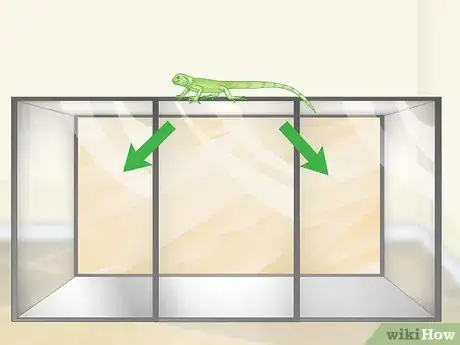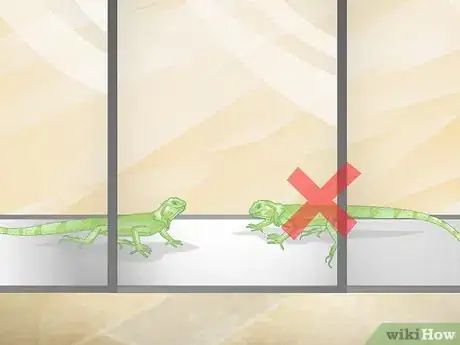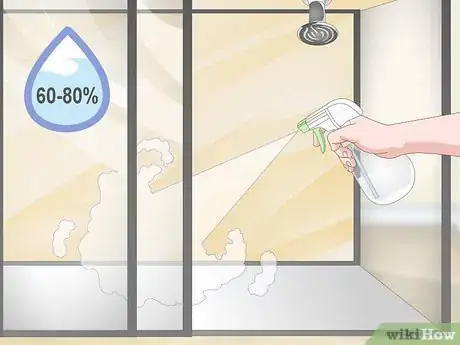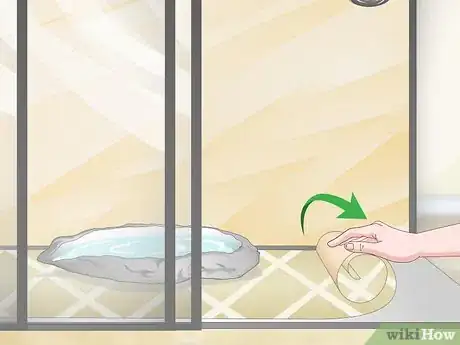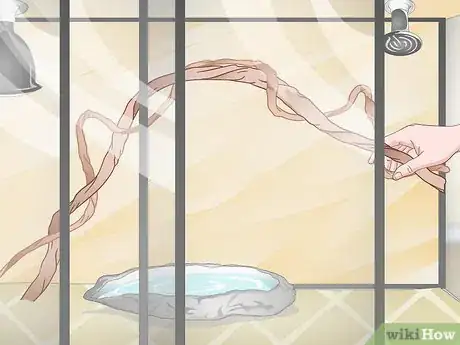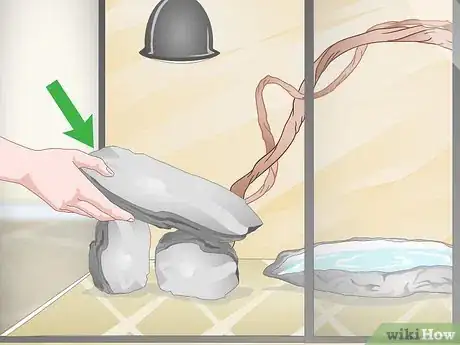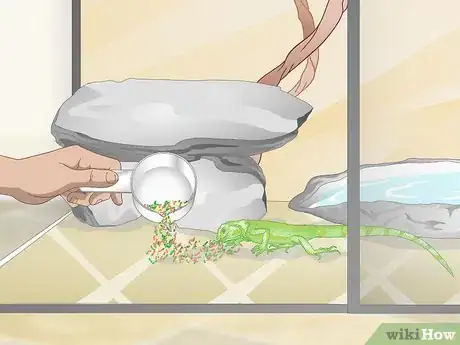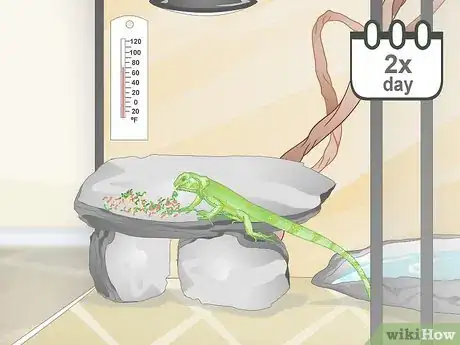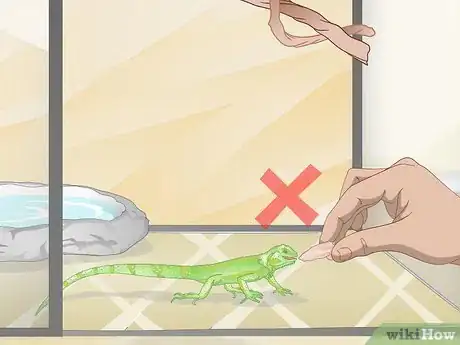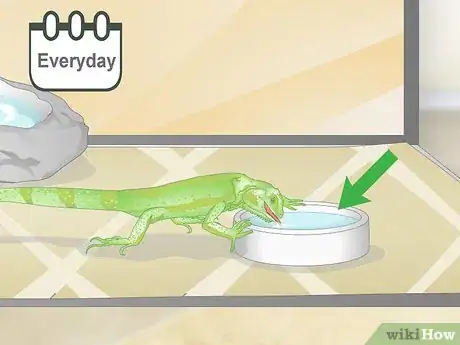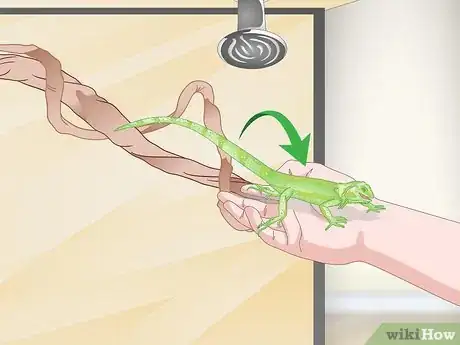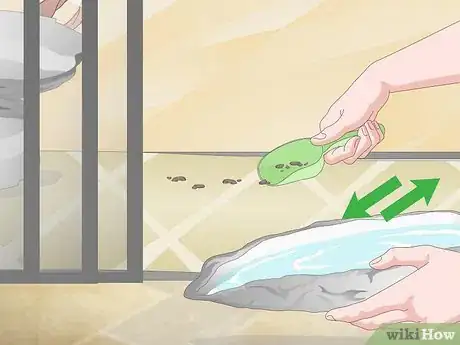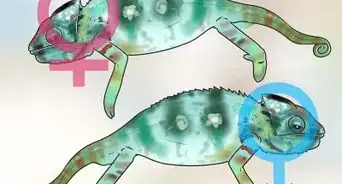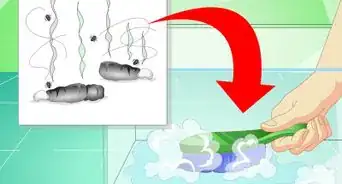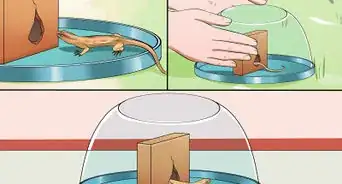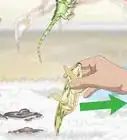This article was co-authored by Jaime Nalezny, DVM and by wikiHow staff writer, Jessica Gibson. Dr. Jaime Nalezny is an exotic animal veterinarian with over 15 years of experience, focusing on the care of birds, reptiles, amphibians, and exotic small mammals. Dr. Nalezny founded The Iguana Relocation Network and is on the board of directors for Midwest Avian Adoption & Rescue Services. She graduated from the University of Minnesota College of Veterinary Medicine in 2005.
There are 9 references cited in this article, which can be found at the bottom of the page.
This article has been viewed 17,474 times.
It's hard to believe that your energetic little hatchling will soon become a large green iguana. These personable pets grow quickly and can live for 20 years with the proper care, so be prepared to look after your pet for a while. Set it up in a comfortable enclosure that has an ambient heating system and UVB light. Let the hatchling get used to you as you feed it leafy greens and fresh produce. Then, enjoy watching your little iguana grow!
Steps
Creating the Right Environment
-
1Purchase an enclosure that's at least 3 times the iguana's size in all directions. Although green iguana hatchlings are under 1 foot (30 cm) long, they'll grow quickly. Select an enclosure that's 3 times your iguana's height, 2.5 times its length, and 2.5 times its width. Be prepared to move your iguana to a larger enclosure as it grows.
- Ideally, choose an enclosure with a door on the side rather than an opening in the top. This can prevent you from scaring your iguana when you need to reach your hands inside the enclosure.
- Within 1 year, your iguana will grow to about 2.5 ft (0.76 m) long.
Did You Know? Your baby green iguana may grow up to 6 ft (1.8 m) once it reaches adulthood.
-
2House your iguana by itself. Don't put more than 1 iguana in an enclosure or add any other animals, including other reptiles, to your pet's habitat. Green iguanas do best when they are alone in an enclosure.[1]
- Green iguana hatchlings do better in environments that they can safely thermoregulate and bask in without stress. They are very smart creatures and need to be able to forage for food as a form of enrichment.
Advertisement -
3Install an ambient heater to provide warmth. Since green iguanas are cold-blooded, their environment needs to be warm. Choose an ambient heater rather than an under-tank heater to prevent your iguana from getting thermal burns. Set the heater so there's a basking area at 105 °F (41 °C) for your hatchling, an ambient temperature of 90–100 °F (32–38 °C) in a warm area, and a cool area that's around 75–88 °F (24–31 °C).
- Make sure the temperature in the tank does not drop below 72 °F (22 °C).
- Under-tank heaters and heat rocks aren't reliable sources of heat and they can burn your hatchling.
- Use a temperature gun to measure the height and adjust the heater's bulb wattage and the bulb's distance from the tank if you need to make changes.
-
4Keep the humidity of the tank between 60-80%. Iguanas are a rainforest species and need plenty of humidity in their enclosure. Install a pump sprayer or mist the iguana's habitat every few hours. Additionally, make sure there's good ventilation in the enclosure.
-
5Set up a UVB light to help your hatchling absorb nutrients. Buy a UV light that puts out between 290 and 320 nanometers of UVB light and place it about 6 to 12 inches (15 to 30 cm) away from your hatchling's basking spot, such as above a large flat rock. In order for your hatchling to get the UVB light, there can't be plastic or glass between them, so consider attaching it to the underside of the enclosure's lid.
- The UVB light will help your baby iguana make vitamin D so it can absorb calcium.
- The lightbulb will weaken over time, so get a meter that can measure the rate of decay and replace the bulb when it's working at 70% of the original output.[2]
-
6Put a linoleum substrate and bathing dish in the bottom of the enclosure. Iguanas don't spend much time on the ground, so there's no need for a substrate like reptile carpet or newspaper. Cover the bottom of the enclosure with linoleum, then cut out a hole so you can sink a bathing dish, like a ceramic container filled with water, underneath it.[3]
- Choose a non-porous, non-plastic container that is shallow but large enough to allow your iguana to submerge itself. Be sure to disinfect and refill their bathing dish daily as they will eliminate it.
- Green iguanas can learn to swim when they're just a few days old, so let your hatchling practice in their tank. Fill the swimming dish with tap water and place items, such as branches or rocks, around it so the hatchling can get in and out of the water easily.
- Your baby hatchling will also become hydrated by swimming so keep the dish filled with water.
-
7Give the hatchling branches and platforms to climb. Green iguanas enjoy hiding, climbing, and basking. Give them spaces for playing as well as resting. For example, put a small cardboard box and branches of different sizes in the enclosure. Choose branches and platforms that allow your hatchling to scramble vertically as well as horizontally. The branches should be about as wide as the iguana's width.[4]
- Use branches that aren't sticky or oozing sap.
- If your iguana seems shy and often hides, work on socializing it. You can also put plant screening in front of the enclosure so your pet feels more secure in its habitat.
Tip: You can place live plants into the tank, but they should be non-toxic since the hatchling may eat the leaves.
-
8Set a large rock in the tank for the hatchling to bask on. Place several smooth, flat rocks in the tank for your hatchling to scramble around on. It can use these to wear down its sharp toenails and it will probably pick a large rock so it can bask under the UVB light.
- Put rocks that are different sizes in the tank so your hatchling can select one it likes.
Feeding the Hatchling
-
1Offer the hatchling freshly grated or chopped vegetables. Green iguanas are herbivores, so you'll need to give them lots of fresh greens, such as collard greens, dandelion, turnip greens, endive, escarole, and mustard greens. Since they don't use their teeth to chew, finely dice or mince the greens and vegetables or fruit. Your hatchling might also enjoy:
- Raspberries
- Green beans
- Snow peas
- Dark orange squash
- Mangoes
- Papayas
- Blackberries
- Figs
Tip: To prepare hatchling food in a hurry, put the produce into a food processor. Process the food until it's fine enough for your hatchling to swallow easily.
-
2Feed the hatchling room-temperature food 2 times a day. Put a dish with leafy greens and diced vegetables into the tank in the morning and discard uneaten food after 2 hours. Then, feed the hatchling fresh food in the afternoon. It may take a little time for the hatchling to become interested in the food, but keep offering it.[5]
- Make sure the pieces of food are smaller than the space between the iguana's eyes.
- The amount of food you should give will depend on your unique hatchling. Keep in mind that the hatchling will go through several growth spurts where it eats more.
- To keep your hatchling healthy, throw away food that's been sitting out for more than 2 hours and clean the food bowl.
-
3Do not feed your hatchling meat or large pieces of food. Iguanas are herbivores and feeding them meat can result in kidney failure or even death. Additionally, your green iguana hatchling can't chew so it won't be able to digest food that hasn't been shredded or finely chopped. Avoid giving the hatchling cat food or dog food since these don't have the right balance of nutrients.
- If you wish to supplement your iguana's diet with a small amount of commercial iguana food, moisten the pellets before offering them.
- Although iguanas are vegetarians, avoid feeding them foods that contain goitrogens or oxalates, such as in spinach or kale, cabbage or brussels sprout, broccoli, rutabagas or turnips, and bok choi.[6]
-
4Give your hatchling access to fresh water every day. If your hatchling is eating a lot of fresh vegetables, they'll stay pretty hydrated. It's still important to place a shallow dish of fresh water in the tank every day so the hatchling can drink if it wants to. Clean and refill the drinking dish each day.[7]
- Ensure that the hatchling can easily get out of the water dish if it accidentally falls in.
- Use a non-porous dish not made from plastic.
Keeping Your Hatchling Happy and Healthy
-
1Handle your hatchling every day to help it socialize. Let the hatchling become comfortable around you before you even try to pick it up. Start by offering it food from your open hand a few times a day. Once the hatchling eats from your palm, try stroking it while you talk to it. Eventually, you can try to pick the hatchling up with both hands.[8]
- To hold the hatchling, keep one hand under its chest and abdomen so it feels supported.
- Never pick up the hatchling by its tail since it could break off. Its tail can regrow, but it will look different.
- Begin by handling the iguana for only 5-15 minutes each day. Move slowly so as not to startle your pet and be consistent.
-
2Remove feces immediately and clean the bathing dish once a day. As soon as you notice feces in the enclosure, scoop it up and discard it. Then, use a disinfectant wipe to clean the linoleum substrate. Also, remove the bathing dish and empty the water daily. Clean it out with a product like Ajax or Comet, rinse it thoroughly, then refill it and put it back in the enclosure.
- Additionally, take your hatchling out of the tank once a week in order to thoroughly clean the enclosure. Wipe the empty enclosure with a diluted bleach solution (1 part water to 32 parts bleach) and let it dry thoroughly before you put everything back.[9]
Warning: Clean your iguana's dishes in a designated area like a basement sink. Always clean and disinfect the sink afterward. Never clean the iguana's dishes or enclosure in an area where you prepare food or eat (like the kitchen) to prevent the transmission of salmonella.
-
3Keep the hatchling away from other pets. Your little iguana can be easily frightened by larger pets that are unpredictable. Put the iguana enclosure in a room away from cats, dogs, or pet birds since these can distress the hatchling. If your hatchling is stressed, it may lose weight, look skittish, or turn a darker color.[10]
- If you have small children at home, teach them to be calm when they're around the hatchling. Don't allow them to tap on the enclosure or stick their hands inside of it. Supervise them if they want to hold the iguana.
-
4Take your hatchling to the vet once you bring it home and twice a year thereafter. Schedule a vet check-up for a few days after you bring your iguana home. Bring a hot, fresh stool sample to the appointment along with all of the supplements you're providing, a list of food you feed your iguana, the brand of lights in the enclosure, a picture of the habitat, and measurements of the humidity and temperature for each area of the enclosure.
- After the initial appointment, bring your iguana in a check-up at least twice a year or as often as your vet recommends.
- If you spot any signs of illness such as weakness, loss of appetite, muscle twitching, curved bones, lethargy, swelling of the toes or legs, lumps or bumps, a pink tinge to the skin, crusty skin, diarrhea, sunken eyes, or problems with the nails, take your pet to the vet immediately.[11]
Things You'll Need
- Enclosure
- UVB light
- Ambient heat source
- Linoleum substrate
- Food and water dishes
- Water dish for swimming
- Branches, platforms, and rocks
References
- ↑ http://reptilerapture.net/green-iguana-caresheet.html
- ↑ http://uvguide.co.uk/
- ↑ http://www.anapsid.org/pdf/icfs.pdf
- ↑ http://www.avianandexotic.com/care-sheets/reptiles/green-iguana-fact-page/
- ↑ https://www.animalwised.com/feeding-a-baby-iguana-501.html
- ↑ https://www.safarivet.com/care-topics/reptiles-and-amphibians/iguana/
- ↑ https://vcahospitals.com/know-your-pet/iguanas-feeding
- ↑ http://www.avianandexotic.com/care-sheets/reptiles/green-iguana-fact-page/
- ↑ http://nswfmpa.org/Husbandry%20Manuals/Published%20Manuals/Reptilia/Green%20Iguana.pdf
